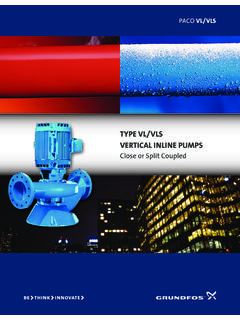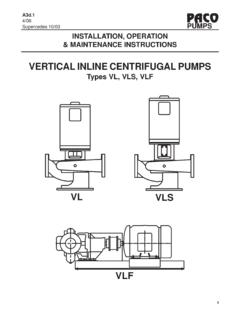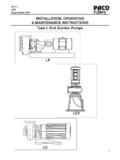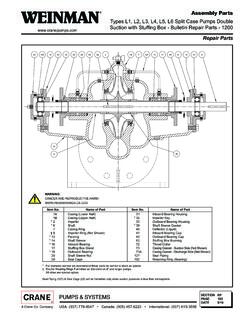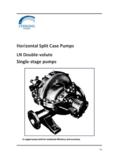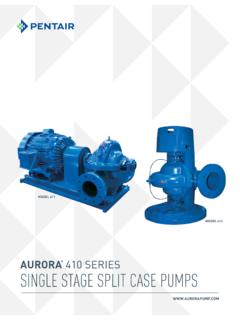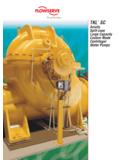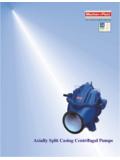Transcription of B1d.1 PACO 4/06 PUMPS Supercedes 8/05 INSTALLATION ...
1 8/05 PACOPACOPACOPACOPACOPUMPSINSTALLATION, OPERATION ANDMAINTENANCE INSTRUCTIONSPACOPACOPACOPACOPACOSPLIT CASEPUMPSTYPE KP & TYPE 8/05 PACOPACOPACOPACOPACOPUMPSTABLE OF - MECHANICALA. Pump 3B. 3C. Temporary 3D. 3E. Pump 3F. Securing The Base 4G. 4H. Suction Inlet Outlet 5J. Shaft Sealing-General 5K. Gland 5-6L. Mechanical 6M. Coupling 6II. INSTALLATION - ELECTRICALA. 7B. Pre-Start 7C. Motor 7D. Starting The 8E. Pump 8F. Short Duration 8G. Extended Period 8IV. MAINTENANCEA. Motor 8-9B. Pump Bearing Lubrication-General 9C. Stuffing Box Packing Shaft Seal-Water 10D. Packing 10E. Disassembly for maintenance -General 10F. Bearing, Seal, & Packing Seal Replacement, Each Side .. 11-12G. Disassembly of Horizontal PUMPS .. 12H. Disassembly of Vertical PUMPS .. 12J. Reassembly of 12 & 15V.
2 ORDERING TROUBLESHOOTINGA. Symptoms .. 16B. Possible 16-17 VII. AND SERVICE and WARNINGS are inserted at key points of this manual to provide check points for personneland machinery safety. CAUTIONS: Apply to personnel. WARNINGS: Apply to personnel and 8/05 PACOPACOPACOPACOPACOPUMPSI. INSTALLATION - MECHANICALAll installations should be performed by personnel expe-rienced with the placement, connection, and alignmentof pumping equipment. The following instructions are gen-eral in nature, and may not deal with the specifics ofyour INSTALLATION . Read these instructions thoroughlybefore installing and operating your PACO Type KPDouble Suction Centrifugal split case Pump. Suc-cessful operation depends on careful attention to the pro-cedures described in Sections I, II, III and IV of thismanual. Keep this instruction manual handy for PUMP IDENTIFICATION All PACO PUMPS are identified by Catalog andSerial Numbers.
3 These are stamped on the pumpnameplate (Figure 1) affixed to each pump casingand should be referred to in all correspondence withthe Company. PACOPACOPACOPACOPACO FIGURE 1aB. RECEIVING Check pumping unit for shortages and damagesimmediately upon arrival. Pump accessories, whenrequired, are packaged in a separate container andshipped with the unit. If equipment is damaged in transit, immediatelyreport the damage to the truck line s a complete report on the freight bill to speedsatisfactory adjustment by the carrier. Unload and handle the equipment with a slingor tow motor. Do not lift unit by lifting lugs on thepump case or eye. Eyebolts on the motor! These are not intended tosupport the complete pump assembly but to aid inC. TEMPORARY STORAGE If the pump is not to be installed and operated withina few days after arrival, store in a clean, dry areaof moderate ambient temperature.
4 Rotate the shaft by hand monthly to coat the bear-ings with lubricant and retard oxidation and corro-sion. Where applicable, follow motor manufacturer sstorage LOCATION Locate the pump as close to the suction supply aspossible. Use the shortest and most directsuc-tion piping practical. Refer to paragraph H. SUC-TION (INLET) PIPING. Locate the pump below system level whereverpossible. This will facilitate priming, assure asteady liquid flow, and provide a positive suctionhead. Make sure sufficient NPSH (Net Positive SuctionHead) is provided at the suction end by consideringthe pump s location in relation to the entire sys-tem. Available NPSH must always equal or exceedrequired NPSH specified on the pump performancecurve. Always allow sufficient accessibility for mainten-ance and inspection. Provide a clear space withample head room for use of a hoist strong enoughto lift the unit.
5 Make sure a suitable power source is available forthe pump motor. Electrical characteristics shouldmatch those specified on the motor data plate,within the limits covered in Sections II & III. Avoid pump exposure to sub-zero temperatures toprevent pump liquid from freezing. If freezingconditions exist during shutdown periods, seeSec-tions IIIE and IIIF for specific PUMP FOUNDATION Your Type KP pump should be permanently installedon a firm, concrete foundation mounting pad of suffi-cient size to dampen any vibration and prevent anydeflection or misalignment. The pad may float onsprings or be a raised part of the equipment roomfloor. The foundation should be poured without in-terruption to 3/4 to 1-1/2 inches below the final pumpelevation. The top surface should be well scored orCAT #:29-20951-120061-1741 STOCK #:SER #: #####97X12345 BROOKSHIRE, TEXAS34014412 PUMPS " 8/05 PACOPACOPACOPACOPACOPUMPS grooved before the concrete sets to provide a suit-able bonding surface for grout.
6 Anchor bolts shouldbe set in pipe sleeves for positioning allowance, asshown in Fig. 2a. Allow enough bolt length for grout,lower base plate flange, nuts and washers. Allowthe foundation to cure several days before proceed-ing with pump SECURING THE BASE PLATE After the concrete pad has been poured and set,lower the pump base plate over the anchor bolts andrest it on loose adjustment wedges or shims placedG. PIPING-GENERAL Do not use pump as a support for piping! Usepipe hangers or other supports at proper intervals toprovide complete piping support near the pump. Both suction and discharge piping should be inde-pendently supported and properly aligned to insureno strain is transmitted to the pump when the boltsare tightened. Use of expansion joints or vibrationpads does not preclude the need to properly supportthe piping. Do not spring or force piping when makingconnections! Make sure all piping is as direct as possible.
7 Avoid unnecessary bends and (INLET) PIPINGThe sizing and INSTALLATION of suction piping is particu-larly important. It must be selected and installed in amanner that minimizes pressure loss and permits suffi-cient liquid flow into the pump during starting and opera-tion. Many NPSH problems can be traced directly toimproper design of suction piping systems. Observe thefollowing precautions when installing piping: Suction piping should be as direct as possible, andideally the length should be at least ten times thepipe diameter. Short suction piping can be the samediameter as the suction opening. Longer pipingshould be one or two sizes larger (depending onlength), reducing to the diameter of the suction open-ing near the pump. Use an eccentric reducer, with the eccentric sidedown, as shown in (Fig. 3a on page 5) whenreducing pipe diameter to the diameter of the pumpsuction opening.
8 At no time should suction piping be smaller indiameter than the pump suction opening. Horizontal suction lines should follow an evengradient, if possible. A gradual upward slope to thepump is recommended for suction lift conditions,and a gradual downward slope for positive suctionhead. Avoid any high points, such as pipe loops, as shownin (Fig. 4a on page 5), that may create air pocketsand throttle the system or produce " along each side. Shims or wedges must be placed to raise the bottomof the base 3/4" to 1-1/4" above the pad, allowingclearance for grout. Level the pump shaft, flanges,and base plate using a spirit level, adjusting thewedges or shims, as required. Check to make sure the piping can be aligned to thepump flanges without placing any strain on eitherflange. After pump alignment has been established, putnuts on foundation bolts and tighten them just enoughto keep the unit base plate from moving.
9 Construct aform or dam around the concrete pad and pour groutin and around the pump base. (See Fig. 2a). Groutcompensates for uneven foundation, distributes theweight of the unit, and prevents shifting. Use an ap-proved, non-shrinking grout (such as Embeco 636 byMaster Builders, Cleveland, Ohio or equivalent).Allow at least 24 hours for this grout to set beforeproceeding with piping connections. After the grout has thoroughly hardened, check thefoundation bolts and tighten if necessary. Recheckthe pump alignment after the foundation bolts are TO FORGROUTDAMPIPE SLEEVEWASHERWEDGES OR SHIMSLEFT IN OF FOUNDATION LEAVEROUGH CLEAN & WET DOWNGROUTFIGURE 2a: Anchor Bolt 8/05 PACOPACOPACOPACOPACOPUMPS Install a valve in the suction line to isolate thepump during shutdown and maintenance . Valves should always be installed in positionsthat avoid air pockets. Globe valves shouldnot be used, particularly when NPSH is critical.
10 During pumping operation, valves on the suction linemust always be at FULL OPEN. Pressure gauges properly sized for the range ofoperation, should be installed in gauge taps on thepump suction and discharge DISCHARGE (OUTLET) PIPING Short discharge piping can be the same diameter asthe pump discharge opening. Longer piping shouldbe one or two sizes larger depending on length. Any high points in discharge piping may entrap air orgas and thus retard pump operation. Air vents orbleed valves as a means to release entrapped airare recommended. An even gradient is best for long horizontal runs ofdischarge piping. Install a valve near the pump discharge openingto prime and start the pump. The discharge valve isalsoused to isolate the pump during shutdown SHAFT SEALING-GENERAL COMMENTS PACO offers both mechanical seals and packedstuffing boxes as a means to seal the shaft. Pumpswith stuffing boxes are normally packed before ship-ment.
